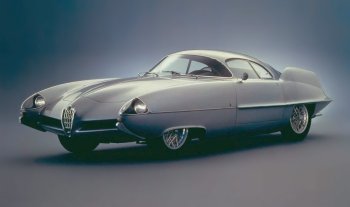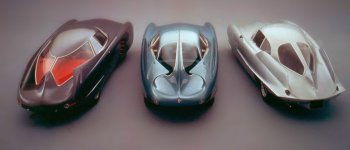 |
ANE has revealed a sketch of
Bertone's planned Geneva Motor Show concept
car, called the BAT 11, which Stile Brtone
Vice Chairwoman Marie-Jeanne Bertone says
will be unveiled on 4th March at the Swiss
show. |
|
 |
|
|

 |
In the mid-fifties the reputation of the
Turin bodywork builder Bertone owed much to
the revolutionary Alfa Romeo BAT 5 line, and
following on from that, the BAT 7 and the
BAT 9. |
|
|
|
Just as Bertone was issuing an official statement on
Thursday that it wouldn't be attenting the Geneva Motor Show
for the first time in more than 50 yeats came contradictory
word that it would be present, and a leaked sketch surfaced
of its planned showcar for the Swiss show that would revive
the famous Alfa Romeo BAT lineage.
"Company
management is being thoroughly restructured," said
Lilli Bertone yesterday morning in a statement, "and as a result of this we are not in a
position to meet the obligations of an event that is so much
in the public eye." Lilli is the Chairwoman of the Stile
Bertone division, which is responsible for the design and
manufacturing of the concept showcars.
The statement added that: "the decision not to go to the Geneva Show falls in with the
Chairman’s request to keep a low profile in matters of
corporate communication, a request that also takes account
of the changed atmosphere in the media in recent weeks."
However within hours Automotive News Europe was
reporting that it has recieved an SMS message from Stile
Bertone Vice-Chairwoman Marie-Jeanne Bertone saying "we will
be at the show". ANE also revealed a sketch of the
Turin firm's planned Geneva Motor Show concept car, called
the BAT 11, which Marie-Jeanne says will be unveiled on 4th
March at the Swiss show.
Marie-Jeanne and her mother, Lilli, have been at loggerheads
with each other ever since 72-year-old Lilli made a surprise
announcement that she proposed to sell the company to the
turnaround specialist Domenico Reviglio on 2nd January.
Marie-Jeanne (40) and her younger sister Barbara (39), a
former Bertone Managing Director, are now both embroiled in
legal proceedings with their mother. At the same time a
Turin bankruptcy tribunal has become involved in the
carrozzeria's future and on Monday it appointed three
commissoners to run the company.
Little detail is
known about the new concept car except that it seeks to
revive Bertone's famous BAT (Berlinetta Aerodinamica Tecnica),
a series of three stunning Alfa Romeo based and badged
concept cars that wowed the automotive world more than fifty
years ago. Sequentially odd numbered, the BAT 5, BAT 7 and
B.A.T. 9 were stars of the biggest motor shows from 1953 to
1955. Taking up the next logical number in the series, BAT
11, this new concept is reportedly once more based on an
Alfa Romeo, this time the 4.7-litre V8 engined Alfa 8C
Competizione. It will be a pure showcar and as such it won't
have an interior.
Bertone BAT
series (1953-55)
In the
mid-fifties the reputation of the Turin bodywork builder
Bertone owed much to the revolutionary B.A.T. 5 line, and
following on from that, the B.A.T. 7 and the B.A.T. 9. The
Berlinetta Aerodinamica Tecnica 5, or B.A.T. 5 takes its
general inspiration from the 1952 Abarth 1400 coupé, and its
mechanics from the Alfa 1900 Sprint. The acronym was a great
hit in the English-speaking world because the car was
actually reminiscent of a bat, with its tail shape hinting
at two tucked-in wings.
The design of the model was based on a study of
aerodynamics. The shape of the front in fact aims to
eliminate the problem of airflow disruption at high speeds.
The design also aims to do away with any extra resistance
generated by the wheels turning, as well as achieving a
structure which would create the fewest possible air
vortexes. In practice these rigorous criteria would allow
the car to reach 200 km/h with the 100 Hp engine mounted as
standard. The design that Bertone came up with was for an
extremely light car (1100 kg), the ultimate in streamlining,
with side windows at a 45° angle respect to the body of the
car and a large windscreen which blends in perfectly with
the almost flat roof. The most surprising part of the car
has to be the tail, with the length-ways rear windscreen
divided by a slim pillar, and the two fins tapering upwards
and slightly inwards, for a highly aesthetic finish. There
was no shortage of positive feedback: the car was an
immediate hit for its aerodynamics and noteworthy stability
at high speeds. Bertone had solved the problem of
aerodynamic stability, creating a car with an excellent
index of penetration.
The Berlinetta
Aerodinamica Tecnica 7, or B.A.T. 7, took up the styling
dictates of the previous model, the B.A.T. 5, and worked
them to the limit. Once again the car was based on the
general idea of the 1952 Abarth 1400 coupé, with Alfa 1900
Sprint mechanics. For this 1954 design, as for the other
B.A.T. models, though less evidently, Bertone added some
elements from his experience working on wing profiles in the
aeronautical industry. The result was the exaggerated shape
of the large, curved tail fins.
In 1955 Bertone
turned in the final design for the B.A.T. project, a series
of prototypes which represented the peak of styling
creativity at the time. The B.A.T. 9 did away with the
marked wing lines of the previous models in favour of a
cleaner, more sober line. The tail fins, which in the other
two models, 5 and 7, had a real wing-like look, were sized
down into two small metal plates. Bertone transformed the
highly creative styling of the two previous B.A.T. models
into design credibility, abandoning the extremes of the
other designs. The more rational, less artistic design of
this prototype, however, does nothing to diminish Bertone's
creative contribution to the Italian school of bodywork
design.
|